Menu
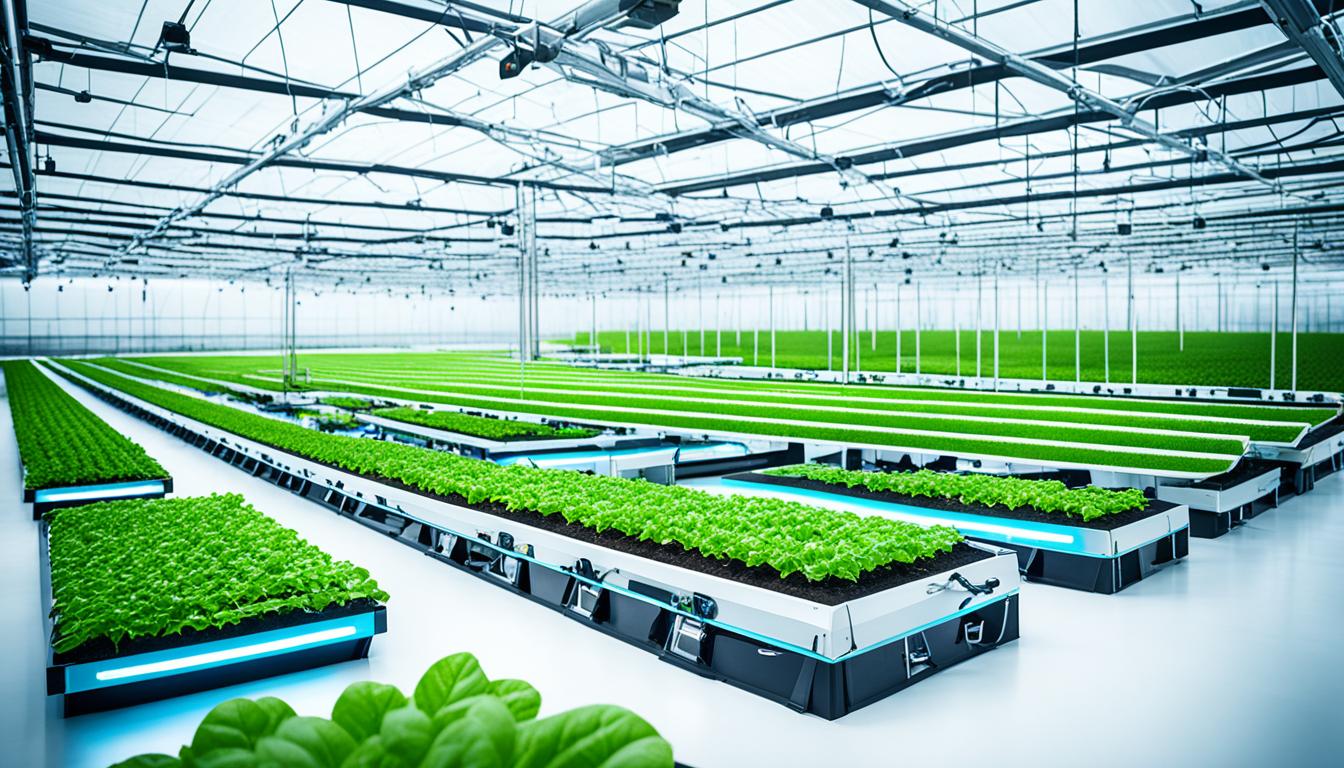
“The future of agriculture is not in the hands of those who work on it but in the hands of those who analyse it.” — Unknown
By 2050, we may reach a population of 9.7 billion. This puts huge pressure on agriculture to do more while using fewer resources. Plus, agriculture has to fight climate change and keep costs down. Digital farming solutions stand out as key technologies in this scenario.
These solutions use data and technologies to make farming smarter and more efficient. For instance, xarvio® Digital Farming Solutions lead in boosting crop production. They help farmers in Europe, Latin America, and North America increase yields with tools like xarvio FIELD MANAGER and xarvio HEALTHY FIELDS.
But it’s not just about more crops. Their ONE SMART SPRAY for weed control is over 95% accurate and can spray day and night. This is possible through LED lights and advanced cameras and sensors from Bosch.
This is all backed by loads of data and smart farming thinking from xarvio. The use of their solutions worldwide, like Yara’s, helped feed millions. For example, adding Atfarm tech in Brazil improved wheat yields by seven bags per hectare.
Climate FieldView™ and similar apps give farmers a better view of their fields using data and satellite images. Drones and soil sensors in fields help watch over crops in real-time. This leads to saving water and other resources.
Digital farming is a new way of combining agriculture technology with farming methods. It makes farming more efficient with smart tools and data. This new method is changing how we do farming by making it smarter. It helps farmers use resources better to grow more food for our planet.
Digital farming uses tech like IoT, AI, and satellite images to get data about farms. Tools like Climate FieldView™ help farmers understand their fields better. This makes it easier for farmers to grow crops well. It also helps them save on water and fertiliser, which is good for the environment.
Now, there’s a big move towards using robots, AI, and IoT in farming. Drones can now spot crop problems like pests and drought early. This helps farmers to deal with these issues before they get worse. There are also sensors in the soil that check moisture and nutrient levels. This info helps farmers use resources more efficiently.

The rise of precision agriculture has changed farming a lot in recent years. Tools like GPS and robots make farming more accurate. This means farmers can react quickly to improve their crops. Plus, AI is making plant breeding better. This leads to stronger and quicker crop growth.
Overall, smart farming is growing fast. It’s all about using the latest tech to farm in a way that’s good for the planet. The goal is to grow more food with less impact on the Earth.
Digital farming solutions have changed the way we farm, bringing many benefits that boost productivity and efficiency. They use modern technologies like automation, IoT, and big data to make the most of resources. This lowers costs and increases crop yields.
Digital farming notably boosts productivity. The DTN ClearAg solution and others help farmers make smart choices, improving how farms are run. This means more production. Technologies like feed management, dairy record keeping, and health monitoring tools for animals play a key role.
Embracing digital farming cuts down on operational costs. It allows for precise monitoring and data-driven decisions, making farming more efficient. The use of automated tools, remote sensing, and precision farming, including autonomous vehicles and drones, helps use resources better.
Digital farming also lightens the regulatory load on farmers. Automation and real-time data make it easier to follow rules, saving money. Furthermore, these technologies improve how farmers get their products to consumers, making their businesses more competitive.
| Benefit | Impact on Farms |
|---|---|
| Increased Productivity | Enhanced management processes, real-time information, and risk management |
| Cost Reduction | Optimised resource use, minimised wastage, reduced regulatory burden |
In summary, digital farming solutions offer huge benefits. They help farmers produce more on the same land and farm in a way that’s good for the environment. This is making farming better for everyone involved.
Precision agriculture is changing how we farm today. It uses high-tech tools like GPS, drones, and satellite images. These let farmers gather and review data instantly. It helps in better managing their farms, boosting both efficiency and profits.
Some important technologies make precision agriculture work well. For example, GPS technology helps make maps of fields and checks soil. It also guides tractors using parallel steering to sow seeds and spread fertiliser accurately. Besides, GIS makes detailed maps from location data, and drones give a bird’s eye view of fields.
Plus, satellites keep an eye on crop health with detailed images. This gives farmers the latest field conditions. It helps them make better decisions quickly.
Precision agriculture brings many advantages. It cuts costs, keeps soil healthy, and reduces reliance on weather. It also helps crops grow as much as they can. Being able to manage things from afar boosts work and cuts costs.
But, there are some challenges too. It means farmers need special gear and software for gathering and studying data. This can be pricey at first. Also, fitting new analytical tools into traditional farming methods takes time and training.
| Technology | Application |
|---|---|
| GPS | Mapping irrigation, soil testing, parallel steering |
| GIS | Creating detailed maps |
| Drones/UAVs | Aerial monitoring |
| Satellite Remote Sensing | Crop health monitoring |
Smart farming tools are changing how we farm. They allow farmers to be more precise and efficient. They’re crucial because the world’s population will grow by 34% by 2050. These tools help boost production, cut costs, and support sustainable farming.
Equipment automation is a big step forward. It means machines can do tasks like watering, spreading fertiliser, and collecting crops on their own. This lessens the need for as much human work. It makes farming tasks more accurate, faster, and easier to keep track of.
Robotics and IoT sensors play a vital role. They make machines smarter, increasing how much food we can grow while lowering costs. Apps that work with smart farming tools mean farmers can respond to what their fields need right away. This quick action leads to better farming outcomes.
Remote monitoring is key in smart farming. It lets farmers keep a close eye on their crops all the time. With sensors and drones, they can check on soil, crops, and the weather with great precision.
IoT brings everything together. It helps farmers use the data they get to make their plants grow better while wasting less. This is seen in how they control pests and diseases, and in watering their crops accurately from afar. It makes farms work more smoothly and helps the environment.
But, these new farming tools do face some hurdles. Not all places have good internet. And many farmers don’t know all the ways these tools can help. Also, the different companies that make the tools don’t always work together. Overcoming these challenges is key to smart farming growing in use for both small and big farms.
Data analytics in agriculture has changed how we farm. It’s becoming more important with the world’s population growing. By 2050, we expect there will be 9.8 billion people. This puts a lot of pressure on farming systems. Using big data and analytics is key to making farming both more efficient and sustainable.
Big data lets us look at huge datasets in agriculture. It helps us see new trends and insights. For instance, spending on analytics in agriculture increased from USD 585 million in 2018 to USD 1236 million by 2023. This shows a 16.2% annual growth. Companies like DTN use modern tools to combine weather and farm data. This way, they can give farmers accurate forecasts.
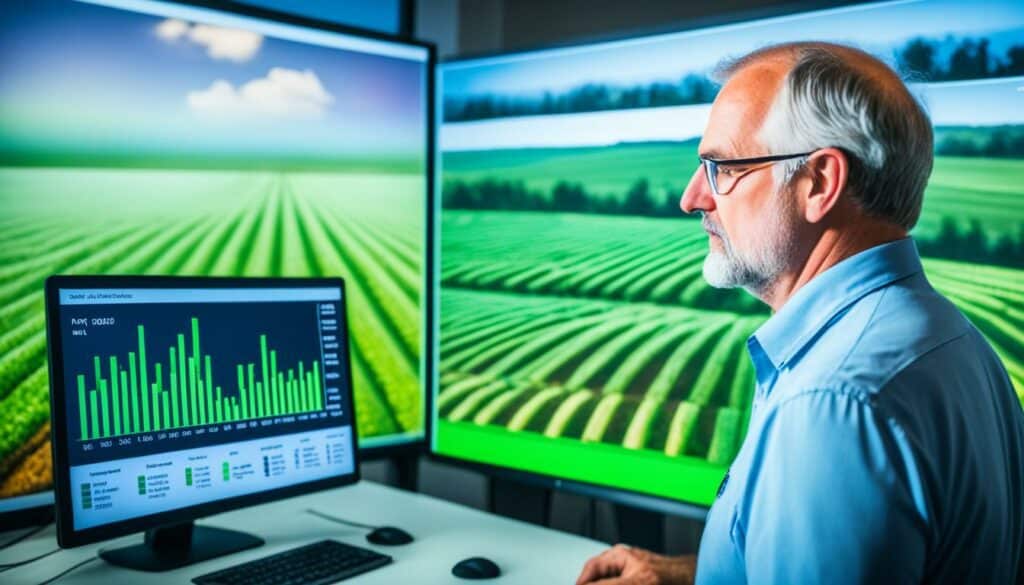
SMAG InVivo’s Data Crop algorithm is a great example of how big data helps. It pulls in lots of different data to make better decisions. In one example, it helps manage 80% of French wheat farms. Cloud computing is also very important. It lets us use a lot of computing power without having huge computers on-site. This means we can do detailed analysis and adjust strategies in real time.
Predictive agriculture uses advanced analytics to spot future problems and opportunities. For example, it can help predict pest attacks or bad weather. This lets farmers act before problems get out of hand. It can have a big impact on how much food we can grow and how sustainably we do it.
Technologies like remote sensing and drones give farmers detailed looks at their crops. This means farmers can take very specific actions. Analytics in agriculture helps reduce waste. It helps use water and fertilisers more efficiently. Tools like Talend Data Fabric help integrate data quickly. This makes farming more efficient.
| Year | Market Size (USD Million) |
|---|---|
| 2018 | 585 |
| 2023 | 1236 |
To sum up, data analytics, big data, and predictive analytics are changing farming for the better. They boost productivity and support sustainable farming. They provide farmers with vital information and encourage smart use of resources.
Farm management software is now key in modern farming. It helps manage many parts of the agri-business. Tools like FarmERP are used in over 25 countries. They manage 600,000 acres of land. FarmERP focuses on Fruit, Flower, and Vegetable (FFV) farming.
This software does a lot. It tracks resources and plans finances. It also boosts farm performance. It’s important for contract farms, FFV exporters, and more.
FarmERP works with scientists on farming innovations. It helps agriculture NGOs too. This includes efforts to build farming skills and improve farm lands.
Now, let’s look at some top farm software companies:
| Company | Employees | Sector | Funding |
|---|---|---|---|
| Solinftec | 501-1000 | Technological Solutions | Undisclosed |
| Ag Leader Technology | 201-500 | Agricultural Technology | Series D |
| Cropin | 201-500 | Farm Management Software | Series D |
| Agrivi | 11-50 | Farm Management Software | Series A |
| SYNAgro | 51-200 | Software | Undisclosed |
Using tools like FarmERP shows how vital digital farming is. These techs help plan and improve farming. They are key to a sustainable and productive future in agriculture.
IoT is changing how we farm, making processes better. It’s set to grow big, from $30.51 billion in 2021 to $78.85 billion by 2030. With food demand rising, using sensors and real-time data is key to meet future needs.
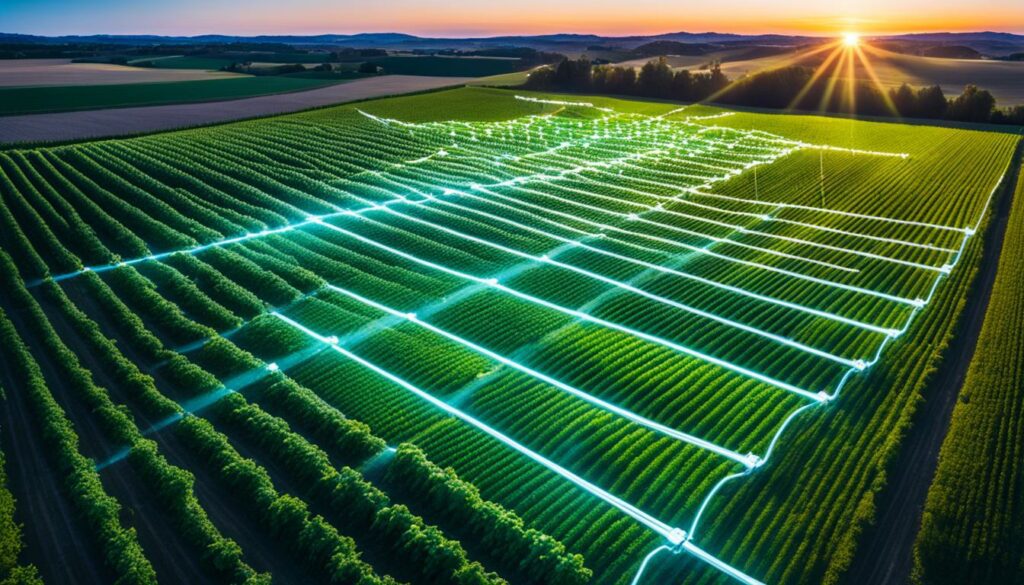
Adding sensors to farming lets us watch and manage things in real time. Now, 80% of farms use IoT, while others are trying it out. These sensors check the soil, look at crop health, and more. They help farmers choose what to do next based on facts, not guesses. This makes farming better and uses less resources.
IoT gives farmers instant data that’s crucial for making the right decisions. With tech like Climate FieldView™, farms can blend their data with science to get smart advice. This advice helps farms save money, use resources better, and be more productive. Plus, machines get smarter, using fuel only when needed.
| Factors | Benefits |
|---|---|
| Sensor Integration | Enhanced production, improved resource consumption, efficient operations |
| Real-time Data | Optimised farming processes, reduced operational costs, precise management |
| IoT Projects | Better customer service, streamlined supply chain |
Using IoT and its sensors in farming is not just about feeding more people. It’s also changing how farms are managed. It’s all about farming smarter and in a way that’s better for the planet.
The world’s population is expected to reach 10 billion by 2050. This puts great pressure on agriculture to produce more. Artificial intelligence (AI) is changing the game in farming. It’s forecasted to play a vital role, with the AI in agriculture market growing to USD 4.7 billion by 2028 from USD 1.7 billion in 2023.
In AI-powered agriculture, predictive analytics makes decisions smarter. It allows farmers to quickly handle a lot of data. This helps analyse market demand, forecast prices, and improve planting and harvesting timings.
This detailed approach means using resources better. It increases crop yields and cuts costs. AI also gives real-time info on crop health, water needs, and pest control. This helps farmers act fast, improving the harvest’s quality.
AI is making farm work automatic, boosting efficiency. Machinery like driverless tractors, farm drones, and robots in greenhouses are more precise and cheaper than manual work.
These innovations improve farming quality and productivity. They automate tasks like checking soil, finding diseases, and managing water. This makes farms run well with less need for people to step in.
AI in farming meets the challenge of increasing food demands. It also keeps farming sustainable. By cutting waste, using resources better, and making smart choices, AI ensures a strong, green future for agriculture.
The world’s population is set to hit 9.7 billion by 2050. This puts a big demand on farming to grow by 70%. To tackle this, we are turning to agricultural robotics and farm automation technology. They promise to make farming more efficient. They also aim to fight labour shortages, go green, and cut costs.
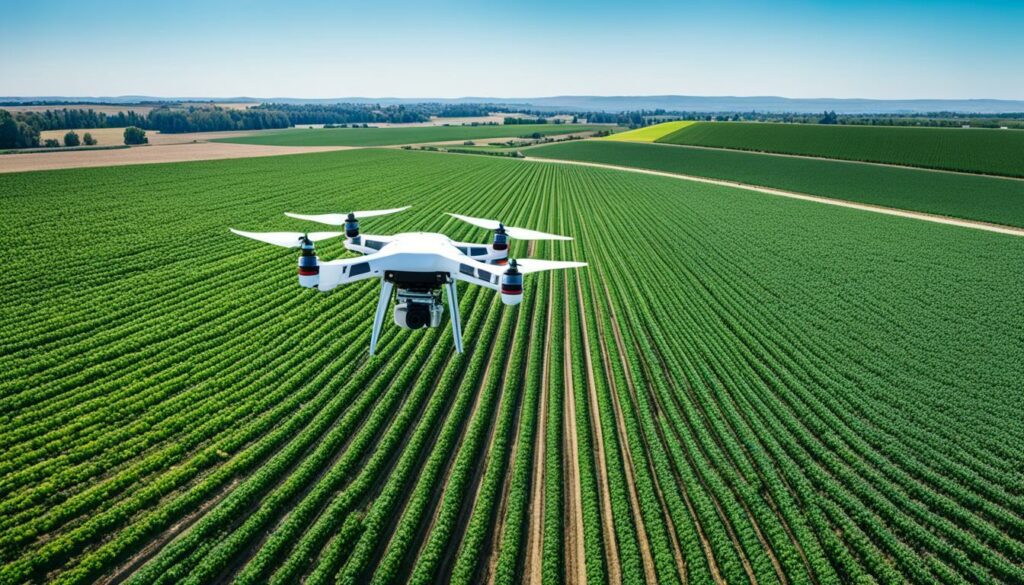
Agricultural robots can do detailed and tough tasks that are costly or hard for humans. Take, for example, a strawberry robot harvester. It can do the work of 30 people in just three days on a 25-acre farm. This tech helps cut down on the main cost of farming: paying workers. Over 50% of farm costs go to labour. Since many farms lack enough workers, about 55% of farmers say they need these new solutions.
Farm automation technology also helps the planet a lot. It can use chemicals like pesticides and fertilisers with great accuracy. This means less chemical use, sometimes up to 90% less. This keeps crops healthy without hurting the environment. Plus, it saves energy and water, making farming greener.
But, getting robots on farms faces some big hurdles. They cost a lot to start with. They may face tech issues or break down. Still, programmes like OurAgTech help new companies in this field. They give them a hand with starting up, connections, advice, and chances to get money. This helps bring new ideas to agriculture through technology.
People are wanting healthier food and more eco-friendly farming. So, we’re seeing more and more of agricultural robotics and automation. This means robots and smart machines are doing more farm work. From planting and weeding to driving tractors, they’re making farming more effective. For example, there are robots that pick apples gently. And, there are smart systems for finding and picking strawberries.
We are still moving forward, solving problems and adopting farm automation technology. This tech is key in feeding the world well and in a way that is good for the planet. It’s changing how we think about and do farming today.
Drones have changed how we monitor crops and soil in agriculture. They use advanced technology for very accurate work. Farmers now have a precise eye on their land thanks to drones.
Drones with special sensors can look closely at crop health. They take thousands of detailed pictures in one flight. This means they can spot issues very precisely, down to 1cm accurately. Special drones can keep flying for hours, great for covering a lot of land. Others, like the DeltaQuad Pro #map, can scan long distances in a single flight.
These drones are also vital for checking on soil. By taking high-quality pictures and using special sensors, they give a deep look at the land. This helps farmers know exactly where to focus their efforts. And it can boost crop growth by up to 5% – a big deal economically.
In some places, like South Korea, they’re a big part of farming. About 30% of spraying is done by drones there. In Australia, drones are even used to make sure crops get just the right amount of water. This is important because our climate is changing.
| Drone Model | Flight Duration | Applications |
|---|---|---|
| DeltaQuad Evo | 4.5 hours | Extensive Field Monitoring |
| DeltaQuad Pro #map | 110 minutes | Corridor Scans up to 50km |
The market for farming drones is growing fast. It’s expected to reach $4.8 billion by 2024. And drones are not stopping there. With developments in AI and even pollination, they’re becoming more useful than ever.
In the farming world, new irrigation systems play a big part in better water use. Tools like Climate FieldView™ help farmers use field data, science, and satellite images. These give very exact information. With drones that use special cameras, we can find out about plant health early.
In-field soil sensors let us know about the soil in real-time. They tell us about moisture and nutrients. These tools help save resources. They fight water shortages, uneven crops, and waste. This makes farming cheaper and more eco-friendly.
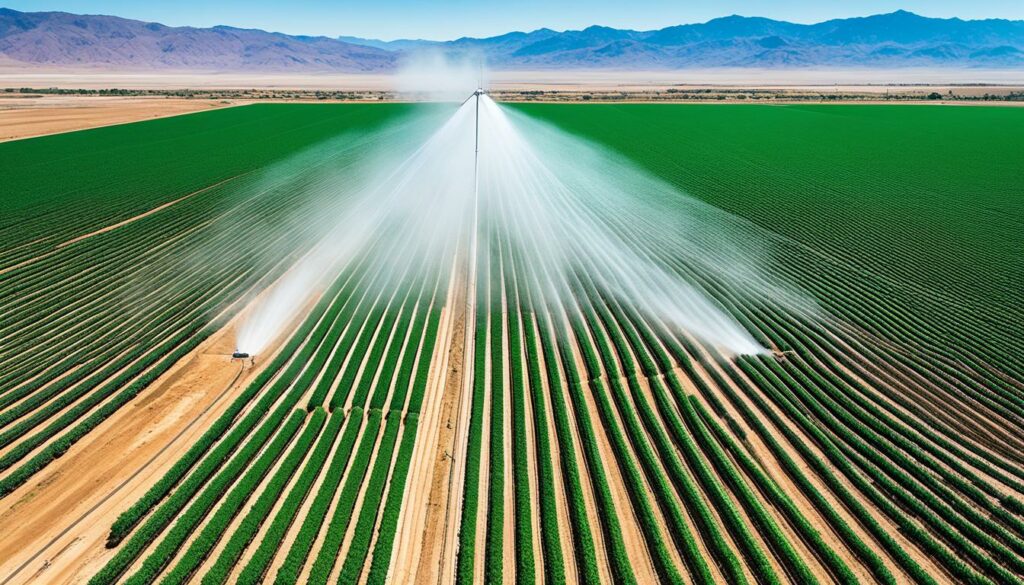
Hitachi and Ag Automation are working together to help farmers grow more. They use devices such as moisture sensors and weather stations. These tools, along with Hitachi’s supply chain control tower (SCCT), make watering crops better. Their work is seen in Idaho, where they help crops like hops and onions.
Smart irrigation brings many benefits to farming. It lowers water use, controls diseases, and helps crops grow better. Using machines to water saves energy and money. It also means farmers can check on their crops from far away.
The SCCT lets farmers track their water use against their plans. This helps protect resources. It makes farming eco-friendlier. Putting together maps and sensor data helps in planning and watching over the farm. Farming is getting more efficient and better for the planet.
Companies like AZUD are leading this change. They offer tools like the AZUD QGROW AT for water and nutrition control. The AZUD SYRA is great for automatic watering. Real-time info from soil and weather probes helps make important decisions. The AZUD DLOG and their Decision Support System help plan watering and feeding well. AZUD mixes old farming ways with new tech perfectly.
Digital tools are changing how we look after animals on the farm. They help farmers keep their animals healthy and boost farming output. With these new technologies, monitoring livestock has become easier and more efficient.
Sensors track key health signs in animals all the time. Devices like mobile near-infrared sensors check the quality of feed instantly. And tools on pig farms can spot breathing problems two weeks earlier. This means farmers can step in sooner to keep their animals well.
Digital tech isn’t just for checking health; it’s also for making farms more productive. For example, cow trackers with phone apps are used for watching their health closely. RFID tags on cows make it quicker to respond to sickness. These tools help farms run better and keep animals healthy.
Digital farming solutions are high-tech tools and tech. They’re made to make farming better. Think of platforms and apps that help to process data, do things with precision, and manage resources well.
Technology in farming is vital today. It tackles the challenges we face from a growing population, climate change, and rising costs. It boosts how much we can produce, keeps our practices sustainable, and helps us use everything we have wisely. This is all possible thanks to smart farming and precision agriculture tools.
Digital farming boosts productivity by keeping a close eye on all the farming activities. It cuts down on waste and makes sure resources are used wisely. This mainly happens with the help of automation, the Internet of Things, and using data smartly.
Going digital can save a lot of money on the farm. It helps use resources better, cuts down waste, and makes operations run smoother. These smart solutions help you make better decisions. This leads to less money spent on running your farm and making the most out of what you produce.
In precision agriculture, we use cutting-edge stuff like sensors, drones, and AI. These tech gadgets gather and study data to help manage the farm better. They up the game in how we use resources and manage our crops. This boosts how efficient and productive our farms are.
The good part about precision farming is it makes better use of our resources, gets us more crop, and manages what we grow better. There are some tough bits too. Starting up with this tech can cost a lot, not all farms are easy to fit into this, and it needs people who are good with tech to make it work.
Smart farming tools, like automatic machines and systems that watch from afar, are changing how farmers do things. They make every task precise and well-controlled. Thanks to real-time checking and doing things on their own, these tools make farming more efficient and productive.
Data analytics in farming uses big data and smart predictions to pull out useful info from big sets of data. This info is used to make smart choices and improve how we plant, water, and gather our crops.
Farm management software is like having a central control for your farm. It brings together many farm tasks, like keeping an eye on resources, planning how to spend money, and checking how the farm is doing. This helps run the farm better and be more effective.
IoT in farming means everything on the farm can talk through sensors and work together in real-time. This makes watching over the farm and making sure things run well much better. The result is a farm that’s more efficient and gets better results.
Artificial intelligence makes farming smarter by helping to decide and do farm jobs automatically. It learns from data and uses this learning to do things better in farming. Thanks to AI, farming is becoming cleverer and driven more by data.
Robots and automatic systems are carrying out jobs in farming, such as planting and reaping, that were too costly for people to do. They change how efficiently the farm runs, cut down on the costs of people working, and lift how much we farm.
Drones look after the fields, checking on how well the crops are and the soil’s health. They’re fast and not expensive, helping us look at big areas quickly. This early look helps farmers make better and quicker choices.
By using sensors and data analytics, the latest in watering tech adjusts how much water each plant gets. It’s all about giving just the water each crop needs. This saves water, lessens waste, and makes farming more long-lasting and productive.
For managing livestock, digital tools with sensors and data are a big help. They keep a constant eye on the animals’ health and how they act. This early tracking of sickness, looking after herds better, and all in all, increasing what we get from our animals.